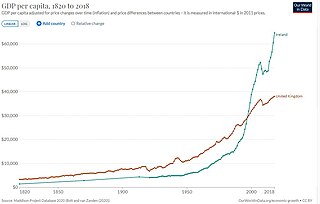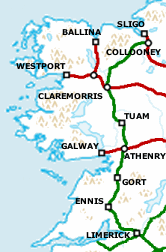
The "Celtic Tiger" is a term referring to the economy of Ireland from the mid-1990s to the late 2000s, a period of rapid real economic growth fuelled by foreign direct investment. The boom was dampened by a subsequent property bubble which resulted in a severe economic downturn.

A bungalow is a small house or cottage that is single-story, and may be surrounded by wide verandas.

Éamon Ó Cuív is an Irish Fianna Fáil politician who has been a Teachta Dála (TD) for the Galway West constituency since the 1992 general election. He previously served as Deputy leader of Fianna Fáil from 2011 to 2012, as Minister for Social Protection from 2010 to 2011, Minister for Community, Rural and Gaeltacht Affairs from 2002 to 2010, and as a Minister of State from 1997 to 2002. He also served as Minister for the Environment, Community and Local Government and Minister for Defence from January to March 2011, appointed to these positions in addition to his own on the resignation of other members of the government.

The Western Railway Corridor is a term, used since c. 2003, for a partly disused railway line running through the west of Ireland. Currently two sections of the line, from Limerick via Ennis to Athenry and from Collooney to Sligo, see regular services, with other sections either closed or only technically classed as open.

Ribbon development refers to the building of houses along the routes of communications radiating from a human settlement. The resulting linear settlements are clearly visible on land use maps and aerial photographs, giving cities and the countryside a particular character. Such development generated great concern in the United Kingdom during the 1920s and the 1930s as well as in numerous other countries during the decades since.

A single-family detached home, also called a single-detached dwelling,single-family residence (SFR) or separate house is a free-standing residential building. It is defined in opposition to a multi-family residential dwelling.
An Taisce – The National Trust for Ireland, established on a provisional basis in September 1946, and incorporated as a company based on an “association not for profit” in June 1948, is a charitable non-governmental organisation (NGO) active in the areas of the environment and built heritage in the Republic of Ireland. It considers itself the oldest environmental and non-governmental organisation in the country, and is somewhat similar to the National Trust of England, Wales and Northern Ireland but based more directly on the National Trust for Scotland. Its first president was the prominent naturalist Robert Lloyd Praeger.
Newstalk is a national independent radio station in Ireland. It is operated by News 106 Limited, a subsidiary of Bauer Media Audio Ireland, and broadcasts under a sound broadcasting contract with the Broadcasting Authority of Ireland.

The Irish property bubble was the speculative excess element of a long-term price increase of real estate in the Republic of Ireland from the early 2000s to 2007, a period known as the later part of the Celtic Tiger. In 2006, the prices peaked at the top of the bubble, with a combination of increased speculative construction and rapidly rising prices; in 2007 the prices first stabilised and then started to fall until 2010 following the shock effect of the Great Recession. By the second quarter of 2010, house prices in Ireland had fallen by 35% compared with the second quarter of 2007, and the number of housing loans approved fell by 73%.
Oldtown is a population centre and townland in the civil parish of Clonmethan in Fingal, County Dublin, Ireland. The R122 road runs through the village linking Naul to St Margaret's and Dublin Airport.

Mayo County Council is the local authority of County Mayo, Ireland. As a county council, it is governed by the Local Government Act 2001. The council is responsible for housing and community, roads and transportation, urban planning and development, amenity and culture, and environment. The council has 30 elected members. Elections are held every five years and are by single transferable vote. The head of the council has the title of Cathaoirleach (chairperson). The county administration is headed by a chief executive, Kevin Kelly. The county town is Castlebar.

The Department for Levelling Up, Housing and Communities is a ministerial department of the Government of the United Kingdom. It is responsible for housing, communities, and local government in England and the levelling up policy. It was established in May 2006 and is the successor to the Office of the Deputy Prime Minister, established in 2001. The department shares its headquarters building, at 2 Marsham Street in London, with the Home Office. It was renamed to add Housing to its title, changed to a ministry in January 2018, and later reverted to a government department in the 2021 reshuffle.
Coimisiún na Gaeltachta, abbreviated CnaG, was an Irish government agency which worked from 2000 to 2002 to draft recommendations to strengthen the role of the Irish language in the Gaeltacht, the Irish-language-speaking area of Ireland. It was established at the instigation of Éamon Ó Cuív, the then Minister of State at the Department of Arts, Heritage, Gaeltacht and the Islands and its work completed under the guidance of his successor, Mary Coughlan. The Irish Government approved the publication of the Commission's report, without commitment.

Jawaharlal Nehru National Urban Renewal Mission (JNNURM) was a massive city-modernization scheme launched by the Government of India under the Ministry of Urban Development. It envisaged a total investment of over $20 billion over seven years. It is named after Pt. Jawaharlal Nehru, the first Prime Minister of India. The aim is to encourage reforms and fast track planned development of identified cities. Focus is to be on efficiency in urban infrastructure and service delivery mechanisms, community participation, and accountability of ULBs/ Parastatal agencies towards citizens.

Mullaghmore is a 180 metre (590') limestone hill in the Burren in Glenquin, Kilnaboy County Clare, Ireland. It is part of a hiking trail called the Mullaghmore Loop in the Burren National Park.
Provision of housing in rural areas is considered inadequate in the United Kingdom and the United States. Programs funded by government are providing some rural housing in the United States and India.

Pól Ó Foighil was an Irish politician and activist for Irish-speaking, coastal and island communities. A teacher turned co-operative manager, he was an active member of the Fine Gael party, and as a long-serving councillor he was the party's only elected representative in the Connemara Gaeltacht for two decades. He also served as a senator from 1989 to 1993.
Low-impact development (LID) has been defined as "development which through its low negative environmental impact either enhances or does not significantly diminish environmental quality".
Michael Smith had the idea for the reward that led to Ireland's Planning Tribunal (1997–2012), was chairman of An Taisce, Ireland's National Trust and largest campaigning environmental NGO (1999–2003), and an activist opposing bad planning and environmental degradation; and is now editor of leftist magazine, Village.
These are the front benches of Micheál Martin from 2011 until the present day.












